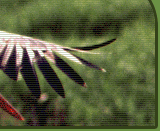 | | Highlander cows in Bebrene | How should the Dviete floodplain be managed? On August 11th, farmers whose farms are located in this specially protected nature territory included in the Natura 2000 network of protected areas, gathered in the Atāli homestead, Bebrene parish. The representative of the Latvian Fund for Nature Andris Klepers informed them about the ways of managing the Dviete floodplain and attracting the EU funding.  | | Highlander cows in Bebrene | How should the Dviete floodplain be managed? On August 11th, farmers whose farms are located in this specially protected nature territory included in the Natura 2000 network of protected areas, gathered in the Atāli homestead, Bebrene parish. The representative of the Latvian Fund for Nature Andris Klepers informed them about the ways of managing the Dviete floodplain and attracting the EU funding. Due to the valuable meadows, only an environmentally friendly management of the Dviete floodplains is allowed and the LIFE-Nature project supports such efforts of farmers and landowners. Namely, for the EU financing they can remove shrubs and mow meadows. For many plant and animal species there are no suitable shrubs, therefore with the assistance of the EU funds particular areas of shrubs are removed each year. In this turn, late mowing of floodplain meadows allows to preserve the diversity and number of unique bird species. A farmer can receive 100 Latvian Lats per 1 ha for removing shrubs, but for mowing meadows - 138 Euros per one ha, although, for example, in Finland owners of biologically valuable meadows receive 400 Euros per one ha. In order to graze the biologically valuable meadows in a natural way, this year the Highlander cows were grazing in the Dviete floodplain, therefore human intervention is not necessary. At the end of the August also the Konik Polski horses will be brought to the Dviete floodplain for grazing. 35 inhabitants from the Daugavpils region have already concluded contracts on mowing the biological meadows and they will receive the aforementioned EU funding. Participants of the seminar told that the government has still not paid compensations to those farmers that have properties in specially protected nature territories and that they have to observe land management restrictions, withal comparing to traditional agricultural territories this prevents them from a further development.  | |  | | Discussing about archeology | | Different tools from | | in Atāli farmstead | | ancestors | The Dviete Floodplain Nature Park was established in 2004 and in total it covers an area of 4989 ha. It is situated in the Dviete and Bebrene parishes of the Daugavpils region, and the spreads to the Olksna and Kaldabruņa parishes of the Jēkabpils region. It is a unique assembling area for migratory aquatic birds in Europe. For example, in spring 2005, almost 30 thousand migratory birds were counted in the Dviete floodplain. In all, 40 species of protected bird known in Latvia or Europe can be met in the Dviete Nature Park. It is interesting that in Europe the Dviete floodplain is one of the best preserved and biggest natural floodplain examples. Regular floods have stimulated farmers to manage the floodplain with environmentally friendly methods, which mean that unique nature values have been preserved. Eight protected plant species can be found here, for example, Shingled Gladiolus, Siberian Iris, Baltic Marsh-orchid, Early Marsh-orchid and Spotted-orchid. | 






